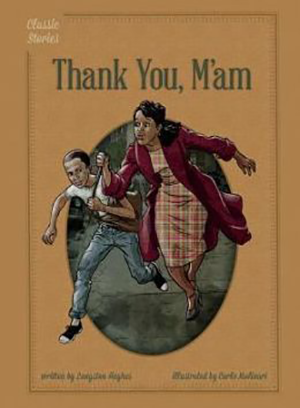 by Langston Hughes
by Langston Hughes
The story “Thank You M’am” is about a boy named Roger who tries to pick-pocket Mrs Luella Bates Washington Jones, but she catches him. She takes him back to her house, tells him to wash his face, gives him food, some money and, most importantly, her advice. She tells him that she wasn’t perfect either in her childhood but teaches him that it doesn’t make it right for him to do the same. When the boy leaves, he is so grateful that he can’t even mutter a thank you or offer any gesture of gratitude.
Strategies/Skills Used
Reading Strategy 1: Accessing prior knowledge.
Reading Strategy 2: Predict what will happen and what will be learned.
Reading Strategy 6: Connect what you read with what you already know.
Reading Strategy 8: Extract information from text, charts, graphs, maps and illustrations.
Reading Strategy 11: Make inferences and draw conclusions.
Reading Strategy 12: Reflect and respond.
Writing Skill 1: I generate ideas in a variety of ways.
Writing Skill 2: I organize my ideas based on my purpose for writing.
Writing Skill 5: I carefully choose the most effective words to express my ideas.
 TEACHING THE ACTIVITY: PRE-READING
TEACHING THE ACTIVITY: PRE-READING
 (1) Using PWIM, show students images of Harlem from the Harlem Renaissance PowerPoint. Download some jazz music to play for the students as well.
(1) Using PWIM, show students images of Harlem from the Harlem Renaissance PowerPoint. Download some jazz music to play for the students as well.
(2) Have students generate words and ideas to show their understanding of Harlem from what they observe when looking at the images and listening to the music.
(3) Discuss connections that can be made between the images, the music and their own lives and experiences. Discuss how this might increase their understanding of Harlem.
(4) Explain to the students that the story they are about to read takes place in Harlem, and show them where Harlem is.
(5) Have students make predictions about possible plot lines for the story, using what they know from the music and images shown.
 TEACHING THE ACTIVITY: DURING READING
TEACHING THE ACTIVITY: DURING READING
![]() (6) Select either the Question/Answer Relationship or the Connect-Extend-Challenge activity.
(6) Select either the Question/Answer Relationship or the Connect-Extend-Challenge activity.
(7) Using the Question/Answer Relationship activity, demonstrate examples of the four QAR categories. Have students highlight lines of the story that resonate with them and fit them into the appropriate box of the four categories.
(8) Using the Connect-Extend-Challenge activity, have students highlight at least four lines from the story that resonate with them. Prompt students by asking them to find lines that connect to main ideas, extend their ideas or raise challenges or questions. Have students sort their lines into the three categories in Connect-Extend-Challenge.
(9) Have students work in small groups, and invite them to choose lines from the story to complete the sentence starters on the Connect-Extend-Challenge worksheet.
(10) Have the groups share their thinking with the class.
 TEACHING THE ACTIVITY: POST-READING
TEACHING THE ACTIVITY: POST-READING
(11) Ask students to pick a character that they would like to deepen their connection to. This can be done individually or in small groups. Lead students to engage in a Collaborative Character Sketch.
 (12) Hand out the Step Inside Character Sketch worksheet and have students imagine themselves as the character. Students will describe and answer the following questions on their worksheet in as much detail as possible:
(12) Hand out the Step Inside Character Sketch worksheet and have students imagine themselves as the character. Students will describe and answer the following questions on their worksheet in as much detail as possible:
- Describe what this character may see, observe or notice.
- What might this person know about, understand or believe?
- What might this person care about? Why would this person care about these matters?
- What might this person wonder about or question?
(13) Have students share their thinking in pairs, in groups or with the class.
(14) Encourage students to be as creative as possible when sharing their ideas. Students could role play/act as the new character in order to share their thoughts on the questions listed above. Example: In pairs, students play the roles of different characters from the story who are meeting each other for the first time. They can ask each other several questions and share their beliefs and views.
 TEACHING THE ACTIVITY: POST-READING EXTENSION
TEACHING THE ACTIVITY: POST-READING EXTENSION
(15) Have students rewrite the ending of the story using Serendipity Writing.